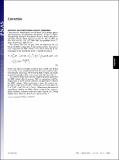| dc.contributor.author | Pivkin, Igor V. | |
| dc.contributor.author | Peng, Zhangli | |
| dc.contributor.author | Karniadakis, George E. | |
| dc.contributor.author | Buffet, Pierre A. | |
| dc.contributor.author | Dao, Ming | |
| dc.contributor.author | Suresh, Subra | |
| dc.date.accessioned | 2018-04-05T14:40:39Z | |
| dc.date.available | 2018-04-05T14:40:39Z | |
| dc.date.issued | 2016-06 | |
| dc.date.submitted | 2016-02 | |
| dc.identifier.issn | 0027-8424 | |
| dc.identifier.issn | 1091-6490 | |
| dc.identifier.uri | http://hdl.handle.net/1721.1/114563 | |
| dc.description.abstract | Red blood cells (RBCs) can be cleared from circulation when alterations in their size, shape, and deformability are detected. This function is modulated by the spleen-specific structure of the interendothelial slit (IES). Here, we present a unique physiological framework for development of prognostic markers in RBC diseases by quantifying biophysical limits for RBCs to pass through the IES, using computational simulations based on dissipative particle dynamics. The results show that the spleen selects RBCs for continued circulation based on their geometry, consistent with prior in vivo observations. A companion analysis provides critical bounds relating surface area and volume for healthy RBCs beyond which the RBCs fail the "physical fitness test" to pass through the IES, supporting independent experiments. Our results suggest that the spleen plays an important role in determining distributions of size and shape of healthy RBCs. Because mechanical retention of infected RBC impacts malaria pathogenesis, we studied key biophysical parameters for RBCs infected with Plasmodium falciparum as they cross the IES. In agreement with experimental results, surface area loss of an infected RBC is found to be a more important determinant of splenic retention than its membrane stiffness. The simulations provide insights into the effects of pressure gradient across the IES on RBC retention. By providing quantitative biophysical limits for RBCs to pass through the IES, the narrowest circulatory bottleneck in the spleen, our results offer a broad approach for developing quantitative markers for diseases such as hereditary spherocytosis, thalassemia, and malaria. Keywords: erythrocytes; microcirculation; spleen clearance; malaria; spherocytosis | en_US |
| dc.description.sponsorship | National Institutes of Health (U.S.) (Grant U01HL114476) | en_US |
| dc.description.sponsorship | National Institutes of Health (U.S.) (Grant R01HL121386) | en_US |
| dc.publisher | National Academy of Sciences (U.S.) | en_US |
| dc.relation.isversionof | http://dx.doi.org/10.1073/PNAS.1606751113 | en_US |
| dc.rights | Article is made available in accordance with the publisher's policy and may be subject to US copyright law. Please refer to the publisher's site for terms of use. | en_US |
| dc.source | National Academy of Sciences | en_US |
| dc.title | Biomechanics of red blood cells in human spleen and consequences for physiology and disease | en_US |
| dc.type | Article | en_US |
| dc.identifier.citation | Pivkin, Igor V. et al. “Biomechanics of Red Blood Cells in Human Spleen and Consequences for Physiology and Disease.” Proceedings of the National Academy of Sciences 113, 28 (June 2016): 7804–7809 © 2016 National Academy of Sciences | en_US |
| dc.contributor.department | Massachusetts Institute of Technology. Department of Materials Science and Engineering | en_US |
| dc.contributor.mitauthor | Peng, Zhangli | |
| dc.contributor.mitauthor | Dao, Ming | |
| dc.relation.journal | Proceedings of the National Academy of Sciences | en_US |
| dc.eprint.version | Final published version | en_US |
| dc.type.uri | http://purl.org/eprint/type/JournalArticle | en_US |
| eprint.status | http://purl.org/eprint/status/PeerReviewed | en_US |
| dc.date.updated | 2018-03-30T18:47:28Z | |
| dspace.orderedauthors | Pivkin, Igor V.; Peng, Zhangli; Karniadakis, George E.; Buffet, Pierre A.; Dao, Ming; Suresh, Subra | en_US |
| dspace.embargo.terms | N | en_US |
| mit.license | PUBLISHER_POLICY | en_US |
